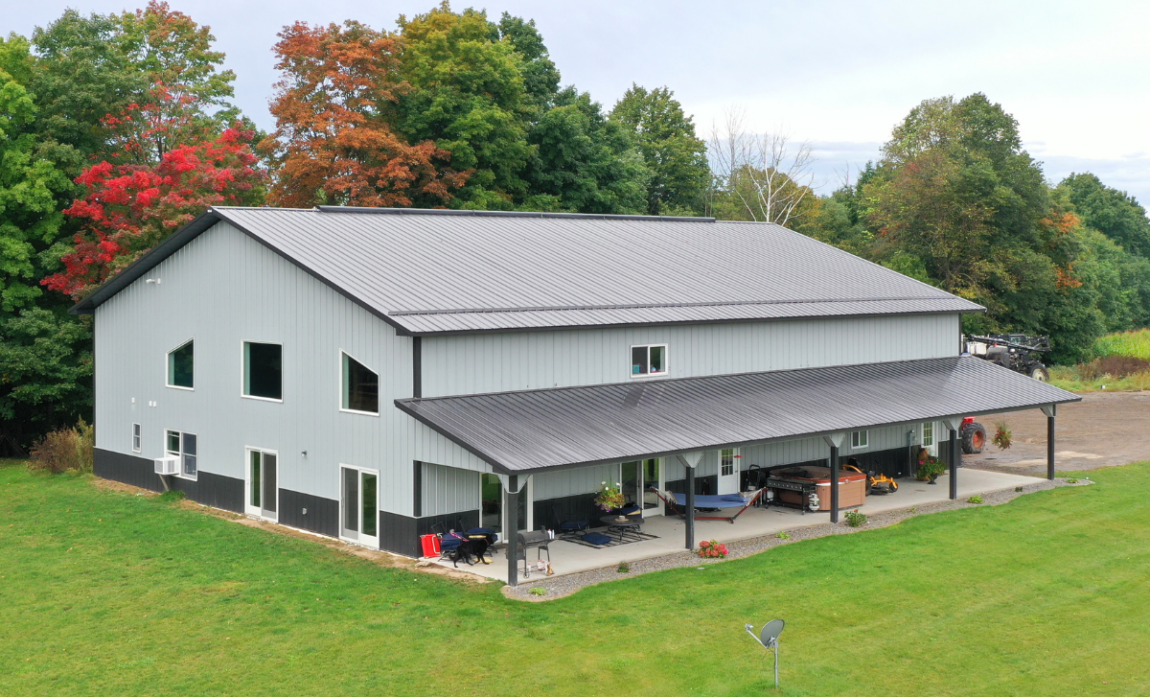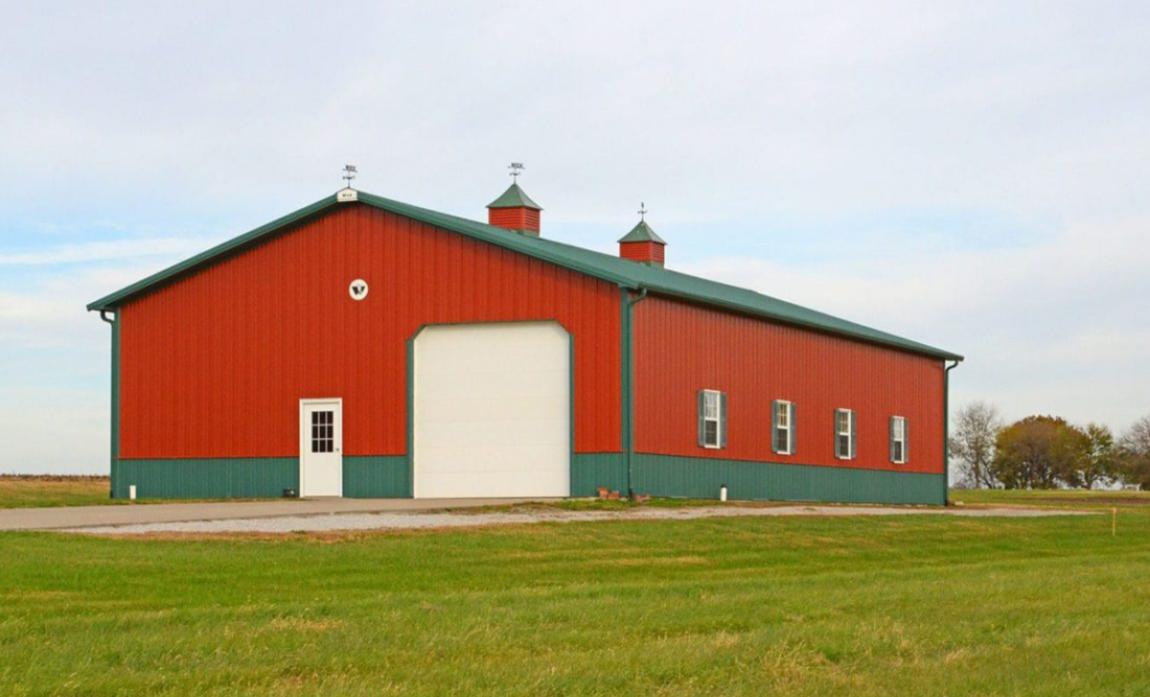Four generations of the Wick family, including Wick Buildings founder John Wick (age 97), recently visited a farm in the Shullsburg area of Southwestern Wisconsin. On the property sits a cattle shed that John Wick himself helped build in the summer of 1955—just a year after the company was founded.
We’ll share more details below, but first a video showing the building still in use after nearly 70 years:
To be clear, we’re not talking about a rickety structure slowly being enveloped in a thicket of wild sumac. Some 68 years later, the original 52’ x 144’ cattle shed is still being used on the flourishing dairy farm of the McComish family.
“Grandpa really lit up when he saw the building,” said John Wick’s grandson Tim Wick, who is also a project sales team member at Wick Buildings. “To think of all the harsh weather it’s endured, plus everything else that a farm building goes through, it was a pretty special moment.”
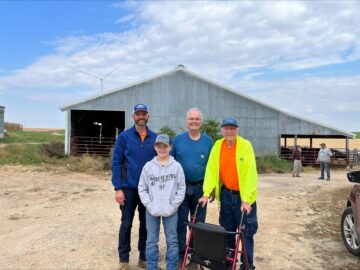
Four generations of the Wick family standing in front of a 1955 Wick cattle shed in Shullsburg, Wisc. (left to right): Tim Wick, project sales team member; Tim’s son Finlay; Tim’s father, Bob Wick, retired from Wick; and company founder John F. Wick. In the background are John Wick, II, retired from Wick; and Tim McComish, farmer and property owner.
An Enduring Building with a Poignant History
Tim Wick said his grandpa immediately began pointing out fascinating details of the building project—like the rough-sawn timbers taken from oak trees that were milled on site.
“It was surreal to stand there and look at the spikes holding those timbers into the wall and know that some of them were driven into place almost 70 years ago by the swing of Grandpa’s hammer,” he said.
Then there’s the remarkable longevity of the cattle shed itself. Although the building may show its age, aside from the roof, the siding, columns, and roof framing are all original. Moreover, as John Wick proudly noted, they’re “all in excellent condition.”
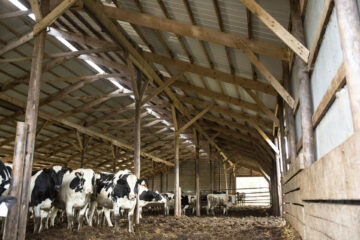
Interior of 1955 Wick cattle shed, including the original siding, roof framing, and rough-sawn timbers that were milled on site.
Perhaps just as remarkable is the significance that the cattle shed holds in the history of Wick Buildings. The contract for the project was written in the spring before summer construction. According to John Wick, that contract “included a critical down payment of $400.”
Why was it critical? Because he’d just formed Wick Buildings the prior year and was still in the midst of getting the company up and running. The down payment for the cattle shed came right around the time, “My cash had run out,” as he put it.
How Wick Buildings Is About More Than Just … Buildings
The McComish property was first settled in 1847 by Tim McComish’s great-great grandfather, who had emigrated from Ireland. As a proud fifth-generation farmer, McComish knows the challenges that can come with running a family business. He’ll tell you that he has a great deal of respect for what John Wick has achieved as a builder and an entrepreneur.
That’s a big reason why he suggested John visit his farm to once again see that 1955 cattle shed. “Those two spent a lot of time together that day talking and looking over the property,” said Tim Wick.
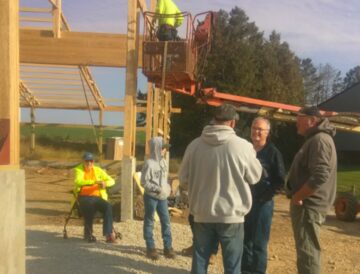
John F. Wick (far left) on the McComish farm, where the seventh recent Wick building was under construction.
In addition to the old Wick cattle shed, there was a lot more for the company founder to see. On the day of the Wick family’s visit, certified Wick builder Brian Steffes from nearby Mineral Point was coordinating the construction of a free-stall dairy barn—the seventh Wick building constructed on the property in the last 20 years or so.
In fact, the McComish farm itself could be considered a testament to Wick Buildings and to founder John Wick’s ingenuity. “First, it shows that quality buildings have been the cornerstone of the company from the very beginning,” said Tim Wick.
He adds that the farm also exemplifies a unique idea his grandpa had for the Wick business model. “We don’t just sell buildings. We’re a collection of trusted independent builders, based in the communities where our customers live. That’s why our legacy is more than physical structures. It’s also the partnerships we form with our customers.”
John Wick’s Vision Made Real
Naturally, some of the building techniques and materials have changed at Wick Buildings in the subsequent decades since that cattle shed was constructed. For example, because of the limited amount of old-growth timber, Wick uses engineered prefabricated laminated posts, or columns, instead of solid round poles (the original reason for the term “pole barn”).
Also, gone are the days of ceiling rafters with accompanying interior load-bearing posts. Today’s Wick buildings use clear span trusses, which help create the expansive, unobstructed spaces that are ideal not only for farm buildings but also everything from event centers and workshops to year-round homes.
“Changes like those reflect how we’ve continually improved the quality and the versatility of our buildings,” said Tim Wick.
That said, the trip to the McComish farm was about much more than buildings, whether old or new. “It was definitely a memorable day to share with my son, my dad, my uncle, and, of course, Grandpa,” he said. “But from a company perspective, it also reminded me that Grandpa’s vision for what a building company should be isn’t just alive—it’s thriving.”


